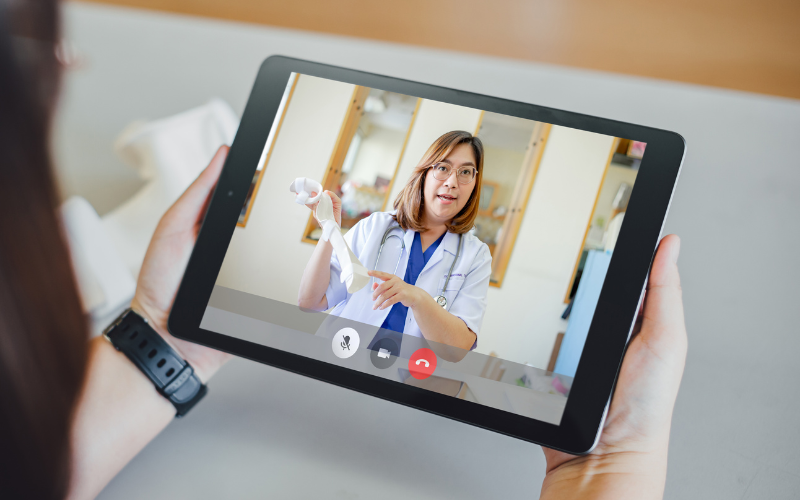
However, there are several logistical barriers when arranging in-person human patient simulations.
Some challenges many program directors encounter include:
- Scheduling, travel, and space limitations
- Limited diversity in patient population based on regional characteristics
- A high demand for SPs resulting in low availability
With remote learning on the rise, access to SPs online has revitalized the path to medical competency. The online format allows for focused training on clinical and diagnostic reasoning, communication skills, and empathetic patient interaction – all essential components of effective healthcare delivery. Learners hone their observational skills, practice active listening, and learn to read subtle, nonverbal cues that help them provide quality care during in-person and virtual appointments alike.
However, it’s crucial to understand that not all online simulations will provide a high-quality learning experience.
Distance Learning with Avatars for Medical Competency
There are a few options when it comes to remote patient simulations. For example, healthcare professionals can “meet” with a virtual avatar programmed to run through a specific scenario.
But while virtual reality and avatar simulations provide some of the same benefits as human simulations online, VR simulators have a few notable drawbacks.
- Avatar patient simulations are not live, free-flowing conversations, so participants don’t get to learn from a human’s real, lived experience.
- AI patient simulations, while more capable of a free-flowing conversation than pre-programmed avatars, lack the true lived experience of marginalized groups and may be more likely to fall into stereotypical behavior unintentionally learned during its training.
- VR simulations are based on a recording, avatar, or animation, which makes it largely inflexible as a learning tool.
- Learners have fewer opportunities to improve interpersonal and communication skills, significantly benefiting from human-to-human interaction.
These non-human alternatives to SPs can be especially fraught when introducing healthcare professionals to culturally affirming care. In trying to teach cultural humility and inclusive healthcare, these virtual options can take away the voice of marginalized groups rather than empowering them, despite the original intention.
Logistical Benefits of Remote Human Simulations
Rather than non-human simulations, another alternative is implementing remote human simulations. Scheduling one-on-one virtual appointments between real human SPs and healthcare learners is more flexible than in-person meetings, yet still provides the human touch that avatars lack.
Program and health system leaders looking to help their learners meet curriculum and continuing education requirements can rely on the many benefits of remote standardized human patients, including:
🗹 Exposure to diverse patient populations: Geographical distance dissolves online, allowing participants to speak and work with people from diverse backgrounds. SP diversity is more than simply checking a box – it’s a crucial experience for healthcare professionals who want to avoid unconscious biases and assumptions in order to provide the best possible care to diverse patient populations.
A platform like Simclusive can help by providing healthcare professionals easy access to people of different regions, cultures, ethnicities, and belief systems without being limited by locale or time-based constraints. Our standardized patient cases are deeply entwined in a culture of inclusivity and humility. We encourage and support the natural curiosity that most healthcare practitioners have and empower them to provide comprehensive care to all patients.
🗹 Simplified coordination and planning: With Simclusive, program leaders can offload the logistics of scheduling, finding a location, gathering enough SPs for all their learners, and communicating with participants. Each learner gets a one-on-one experience designed to help them grow as practitioners at their convenience.
Our online scheduling tools make setting up a human patient simulation quick and easy. Learners simply schedule their desired date and time online, and a standardized patient will confirm the appointment. The sleek participant portal makes it easy to reschedule, cancel, or confirm sessions without involving instructors or delaying learning objectives.
🗹 Clear learning objectives: All programs have stringent academic and practical requirements that their cohort must meet. Standardized patient simulations offer a simple solution for programs and their learners.
We make it easy to reach your goals and demonstrate medical and interpersonal skill competency. With a diverse plug-and-play scenario library, participants can meet their learning objectives and healthcare programs can show that their curricula meet the requirements for accreditation. Our SPs of lived experience are carefully trained in their scenarios so learners can apply their medical competencies while also improving their cultural competencies.
🗹 Effective Feedback Loops: A learner’s primary goal is to learn. Avatar simulations and mannequins can’t meet the fundamental need for performance feedback.
Simclusive’s standardized patients are live human patient simulations online, not virtual SPs. As such, learners have a unique opportunity to engage in a debriefing process and receive immediate, actionable feedback. Learners also receive a session recording and can complete a survey about their experience.
Are you looking to support your program’s curriculum and accreditation efforts and eliminate the logistical headache of planning simulated patient events? Give your learners a flexible online experience rich in diversity, educational value, and skills building.
At Simclusive, learners engage in one-on-one conversations with real people and gain a genuine look into the lived experiences of others while honing technical skills. With over 3,000 successful human patient simulations, we’re breathing life into the virtual learning world.
Contact Simclusive to give your healthcare program a human touch – online.

